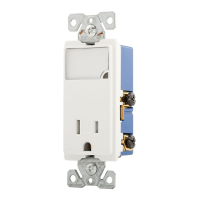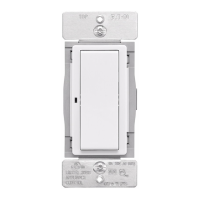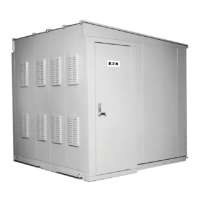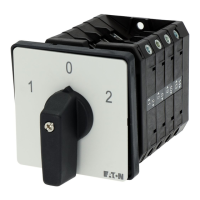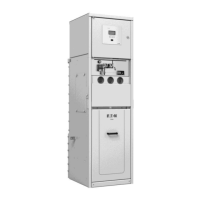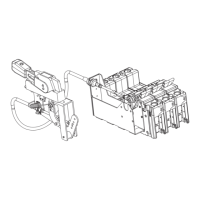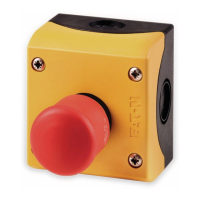14
Technical Data TD00801003E
Effective November 2011
Elevator Control ES Switch
EATON CORPORATION www.eaton.com
5. How does the Special Wiring Option for maintaining
Normal Status Signal to the FACP work?
For Arizona and other areas requiring this feature, internal wiring
between the molded case switch’s auxiliary contacts and the fire
relay’s contacts implements a logic circuit that monitors the
availability of shunt-trip power. The FR relay closes only if the main
switch is ON and the shunt-trip power fails. They will not close if the
main switch is manually turned OFF for maintenance, the Series B
contact will open, thus preventing a false alarm. (Refer to Table 4
and Figure 5).
6. Does the instantaneous trip feature built into the molded
case switch create the potential to strand passengers
when used on circuits with hydraulic elevators and auxil-
iary battery lowering?
No, the Battery Lowering Device (BLD) remains operational under a
shunt-trip condition. The shunt-trip mechanism within the switch is
utilized, not the instantaneous trip feature of the switch. The proper
fuse selection will prevent instantaneous trip. Even in the event
of an instantaneous trip condition, the alarm relay will respond the
same as when the switch is shunted off. There is no potential for
stranding passengers when units are installed with the Mechanical
Interlock Auxiliary Contact Option (Option A, battery back-up feature).
7. During a power loss, will the state of the switch change
state (F1 or F3 option)?
The Eaton Elevator Control ES switch will not change state. The
Eaton Elevator Control ES Voltage Monitoring Relay (F1 or F3 Option)
does meet NFPA 72 (National Fire Alarm Code) requiring control
circuits to be monitored for presence of voltage. The unit is wired
to sense the voltage available to initiate the shunt-trip. It will change
state if a power loss occurs. It does not rely on the shunt-trip itself.
It will send a signal to the FACP upon power loss.
8. How does the Eaton Elevator Control ES switch
decide when the elevator needs to be lowered?
The Eaton Elevator Control ES switch does not make that deci-
sion. It provides a signaling means to the fire alarm controller and
BLD. The Elevator Control switch receives a signal from the FACP
to shunt-trip, which in some cases results in the use of the Battery
Lowering Device (BLD).
9. Does the Eaton Elevator Control ES switch require any
periodic maintenance?
While no specific maintenance is called for, it is always a good prac-
tice to annually inspect the unit for any lose fuse clips or connec-
tions, or accumulation of foreign material. See “Maintenance” in this
document for more details.
10. How do you hook up the dry contacts for the battery
back-up (BLD) option?
This will depend on how the Mechanical Auxiliary Contact (Option
A) will be connected. The A Option will follow the truth table noted
below. The most common connection will be between NC and COM.
Table 5.
Auxiliary Switch Logic
Main Switch
Position
Option A Option B Option A *
NO NC NO NC NO NC
Closed O C O C O C
Tripped C C O C C O
Open C O C O C O
* Auxiliary Switch Logic when blue wire with “+” marker is removed from NC terminal.
Where local authorities having jurisdiction permit, field removal of
the blue wire identified by “+” marker will change the Option A
switch logic. Removal has the effect of disabling the battery lowering
device when the switch is in the tripped position. Field installer must
ensure this meets all local codes before removal.
11. Where do you land the shunt-trip control wires on the
terminal strip?
For the R1 Option (120Vac), land the wires on Terminals 1 and 3 or
NOFAIN and NOFAIN (Normally Open Fire Alarm IN). For the R2
(24Vdc) option, land the positive on Terminal 1 and the closure on
Terminal 3, with the return on Terminal 7.
12. Where does the fire alarm get connected for monitoring
the status of the switch?
This is commonly referred to as the FR relay and is Option F1 or
F3. NCFR/COM FR is the most common. If an end of line (EOL)
resistor is used, install it parallel to the wires.
13. If an Eaton Elevator Control ES switch is ordered with a
wrong component, can the component be changed in
the field?
No. To comply with UL guidelines, product modifications can only be
completed by authorized factory personnel. Other modifications will
void the Eaton UL listing. One exception is the B-option. It can be
ordered and field installed; the part number is ECSBKIT.
14. Can the Eaton Elevator Control ES switch be used as a
service entrance switch?
The Eaton Elevator Control ES switch is UL-Listed per UL 98. Yes, it
can be used as a service entrance if properly labeled as such and
proper ground bond requirements are met.
15. Can the Eaton Elevator Control ES switch be fed in reverse
with the line from the bottom and load out the top of
the switch?
No, the Eaton Elevator Control ES switch will not properly function.

